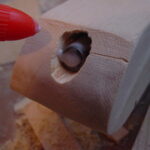This essay continues the examination of the discoveries and technological accomplishments which came about in ancient China. Chinese inventors developed numerous mechanical implements, engineering advances, and new substances such as gunpowder, which took centuries to spread to or be replicated in other parts of the world.
Gunpowder
Gunpowder was invented in China during the 8th Century AD as a mixture of charcoal, sulfur, and saltpeter and used primarily for fireworks. The fireworks were launched from rockets made of hollowed bamboo tubes. These rockets were lighted through use of matches, invented in the 6th Century AD, carved of pinewood and coated with sulfur. Other civilizations borrowed this aspect and discovered its military utility.
In 1150, fireworks were elaborated as a result of the first multi-staged rockets, where several smaller tubes were attacked to main meter-tall stick, which were ignited in mid-air after the main rocket’s energy became depleted.
Natural Gas Drilling
During the 1st Century BC, the Chinese discovered methods to drill some 1.5 kilometers into the Earth’s surface. A derrick was constructed, followed by a small shaft that extended until the Earth’s layer of hard rock was reached. Then a cast iron drill would be lowered with bamboo cables, after which the process would often consume years before any actual fuels were located.
Mechanical Clock
Invented in the 8th Century AD, the mechanical clock rapidly spread to other regions of the world. Chinese designs were crucial to inspiring European clock inventors such as Pope Sylvester II. The Chinese mechanical clock was powered by falling water or mercury, which then transmitted the energy to a chain-drive.
Segmental Arch Bridge
A segmental arch, invented by engineer Li Ch’un in the 7th Century AD, consists of only a small fragment of a circle instead of earlier semicircular arches. Ch’un constructed his first bridge over the Chiao Shui River in 610, which was notably lighter, more durable, and more material-efficient than earlier bridges. It is still in frequent use today.
Belt-Drive
A belt-drive (or driving belt) was attached around wheels to ensure smooth transition of mechanical energy between them. Invented in China during the 1st Century BC, the belt-drive was applied extensively to silk manufacture and spinning machines.
The belt-drive made possible the invention of the spinning wheel in 1270, since it provided sufficient cover and attachment for a rimless construction such as a spinning wheel, where a network of threads replaces the rim.
Sources
1997 World Book Encyclopedia: Vol. 3 C-Ch. World Book Inc. Chicago. 1997.
Franklin Institute Online. China: Ancient Arts and Sciences.” Available March 31, 2002: http://sln.fi.edu/tfi/info/current/china.html
Latourette, Kenneth S. A Short History of the Far East. The Macmillan Company. New York. 1964.
Reischauer, Edwin O. Fairbank, John K. East Asia: The Great Tradition. Houghton Mifflin Company. Boston. 1960.
Schurmann, Franz. Schell, Orville. Imperial China. Random House Inc. New York. 1967.
Think Quest Library of Entries. “Ancient Chinese Technology.” Available March 31, 2002: http://www.thinkquest.org/library/lib/site_sum_outside.html?tname=23062&url;=23062/frameset.html.
Wagner, Donald B. “Liu Hui and Zu Gengzhi on the Volume of a Sphere.” Available March 31, 2002: http://www.staff.hum.ku.dk/dbwagner/SPHERE/SPHERE.html.




